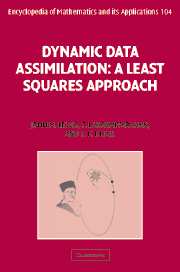Book contents
- Frontmatter
- Contents
- Preface
- Acknowledgements
- PART 1 GENESIS OF DATA ASSIMILATION
- PART II DATA ASSIMILATION: DETERMINISTIC/STATIC MODELS
- PART III COMPUTATIONAL TECHNIQUES
- PART IV STATISTICAL ESTIMATION
- PART V DATA ASSIMILATION: STOCHASTIC/STATIC MODELS
- PART VI DATA ASSIMILATION: DETERMINISTIC/DYNAMIC MODELS
- 22 Dynamic data assimilation: the straight line problem
- 23 First-order adjoint method: linear dynamics
- 24 First-order adjoint method: nonlinear dynamics
- 25 Second-order adjoint method
- 26 The 4DVAR problem: a statistical and a recursive view
- PART VII DATA ASSIMILATION: STOCHASTIC/DYNAMIC MODELS
- PART VIII PREDICTABILITY
- Epilogue
- References
- Index
23 - First-order adjoint method: linear dynamics
from PART VI - DATA ASSIMILATION: DETERMINISTIC/DYNAMIC MODELS
Published online by Cambridge University Press: 18 December 2009
- Frontmatter
- Contents
- Preface
- Acknowledgements
- PART 1 GENESIS OF DATA ASSIMILATION
- PART II DATA ASSIMILATION: DETERMINISTIC/STATIC MODELS
- PART III COMPUTATIONAL TECHNIQUES
- PART IV STATISTICAL ESTIMATION
- PART V DATA ASSIMILATION: STOCHASTIC/STATIC MODELS
- PART VI DATA ASSIMILATION: DETERMINISTIC/DYNAMIC MODELS
- 22 Dynamic data assimilation: the straight line problem
- 23 First-order adjoint method: linear dynamics
- 24 First-order adjoint method: nonlinear dynamics
- 25 Second-order adjoint method
- 26 The 4DVAR problem: a statistical and a recursive view
- PART VII DATA ASSIMILATION: STOCHASTIC/DYNAMIC MODELS
- PART VIII PREDICTABILITY
- Epilogue
- References
- Index
Summary
In the opening chapter of Part VI we considered a very special dynamical model for pedagogical reasons. Having gained some working knowledge of the methodology for solving the inverse problem using the Lagrangian framework, we now consider the general linear dynamical system. Once we understand the underpinnings of this methodology in the context of a general linear dynamical system, its applicability to a wide variety of linear models is possible.
When compared to Chapter 22, the contents of this chapter are a generalization in one sense and a specialization in another. The generalization comes from the fact that we consider the generic linear dynamical system where the state variables are vectors instead of scalars. The specialty, on the other hand, comes from the fact that we only consider the problem of estimating the initial condition instead of an initial condition and a parameter (x0 and α in the straight line problem).
It could be argued that since few models of interest in real world applications are linear, this chapter's value is essentially academic. While this argument carries some weight, it should be recognized that linear analysis has a fundamental role to play in development of adjoint method for non-linear dynamical systems. For example, one standard approach to non-linear system analysis is using the so-called perturbation method. In this method the non-linear problem is reduced to a local analysis of an associated linear system. Next we want to demonstrate that the data assimilation problem is intrinsically challenging, even when the system is controlled by linear dynamics and observations are linear functions of the state variables.
- Type
- Chapter
- Information
- Dynamic Data AssimilationA Least Squares Approach, pp. 382 - 400Publisher: Cambridge University PressPrint publication year: 2006

